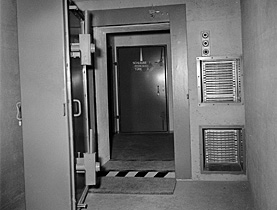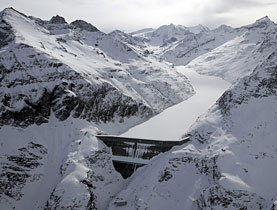The hills are alive with the sound of sirens

On Wednesday Switzerland reverberated to the sound of more than 8,000 sirens as the country carried out its annual test of the devices.
Introduced during wartime, they are now used to alert the population to impending catastrophes or water dangers such as flooding.
Siren testing takes place annually on the first Wednesday of February. Two types of devices were being checked in the afternoon, starting with the general alarm – for which there are 7,500 devices.
“This signal is to alarm the population to a broad range of possible emergency cases from natural disasters to chemical hazards,” Kurt Münger, head of information at the Federal Civil Protection Office, told swissinfo.ch.
“Then there is the water alarm siren for people living in the area below dams, in case of an accident,” he said.
Around 700 of these sirens, which emit a different tone, exist.
Testing times
Testing is carried out by the Federal Civil Protection Office, in coordination with the cantons, communities and dam operators, the aim being to keep these SFr15,000 ($14,200) high tech devices up to scratch.
The population itself should not be alarmed – they are alerted in advance through information campaigns and know there is no action to be taken.
Jürg Hug, head of the Zurich city’s Protection and Rescue section and curator of Switzerland’s only Civil Protection Museum, will be personally testing out one of the city of Zurich’s 72 sirens. But he is not worried.
“In the last years more than 99 per cent of the sirens have worked perfectly,” he told swissinfo.ch.
War alarms
A siren network was first created in Switzerland just before the Second World War when bomb attacks were feared.
“During the Cold War period the network was maintained on the basis of possible military danger, but since the 1980s the reason for the system switched to an alarm for possible catastrophes and emergency cases,” explained Münger.
When hearing a general alarm, people should turn on the radio and listen to the official instructions about what they should do to protect themselves and others.
“It could be that the air has come polluted, such as if a tanker lorry containing poisonous material has fallen over. That would mean staying at home and closing the windows and waiting until the message comes that they could open their windows again,” Hug said.
For the people living in areas with water alarms the advice is different. “People already have the information at home about where they must go in this situation because there’s not enough time to listen to the radio. They have to leave within the space of a few minutes,” he added.
Real life cases
Recent real life cases where the general alarm has been used include Bern in 2007 where the River Aare rose to dangerously high levels. Here the alarm was used in the evening to warn people to protect their belongings and keep away from the river.
In 2008, residents in the small town of Adliswil near Zurich were alerted, again in the evening, to the fact that their water had become polluted and should be boiled before drinking. The water alarm for dams has never been used.
“Our neighbouring countries still have quite a lot of sirens installed but no other country has such a broad system as Switzerland,” explained Münger.
France and Austria each have a network and carry out testing. But Germany dismantled much of its system after the end of the Cold War and has left siren usage up to local authorities. Italy no longer has a network.
English-speaking countries are mixed: many have more or less abandoned their networks. In the United States the devices are used to warn of natural disasters, and, rarely, military attacks.
Swiss unique
The Swiss network is unique because it covers both city and rural regions. “For instance, we not only have fixed sirens but mobile sirens which are installed on top of cars and in case of an alert, are driven along a specific route in a remote region to ensure that people are informed,” Münger said.
So sirens form an important part of the country’s civil protection programme, which also famously includes the provision of underground bunkers – 95 per cent of the population have access to one.
Hug said sirens were vital because they could alert the population at any time, even when the electricity and radio networks were down.
“Compare with Germany… when there were the floods and people couldn’t be informed at night. That’s a dangerous thing, when people sleep and are not listening to the radio. The only thing people can hear are the sirens,” he said.
Isobel Leybold-Johnson, swissinfo.ch
Switzerland currently has around 7,500 (stationary and mobile) civil defence sirens distributed throughout the country that can reach over 99 per cent of the population. An additional 700 water alert sirens are located near dams. The sirens’ range is 250m-1,500m.
The annual siren test takes place in Switzerland on the first Wednesday of February. It is organised by the Federal Civil Protection Office with the cantons, communes and dam operators. At this time, not only general alert sirens but also water alert sirens are tested. It takes place between 1.30pm and 3pm.
People are given advance notice about the siren test on television broadcasts as well as in the newspapers. The siren tests do not require the population to take any special measures.
(Source: ch.ch)
The general alert is sounded when there is a possible threat to the population. Sirens for this alert have a regularly ascending and descending tone lasting a minute and repeated after a two-minute interval. If you hear this alarm signal, you should turn on the radio (Swiss Public Radio or a local radio station), follow instructions from the authorities and alert your neighbours.
A water alert has 12 low continuous tones each lasting 20 seconds. It is activated once the general alert is already sounding. This alarm signal indicates you need to leave the area at risk immediately.
Further information and guidelines can be found on the last pages of all telephone directories in the section “Alerting the population”. Local factsheets contain more information on the Water Alarm.
(Source: ch.ch, Federal Civil Protection Office)

In compliance with the JTI standards
More: SWI swissinfo.ch certified by the Journalism Trust Initiative













You can find an overview of ongoing debates with our journalists here . Please join us!
If you want to start a conversation about a topic raised in this article or want to report factual errors, email us at english@swissinfo.ch.